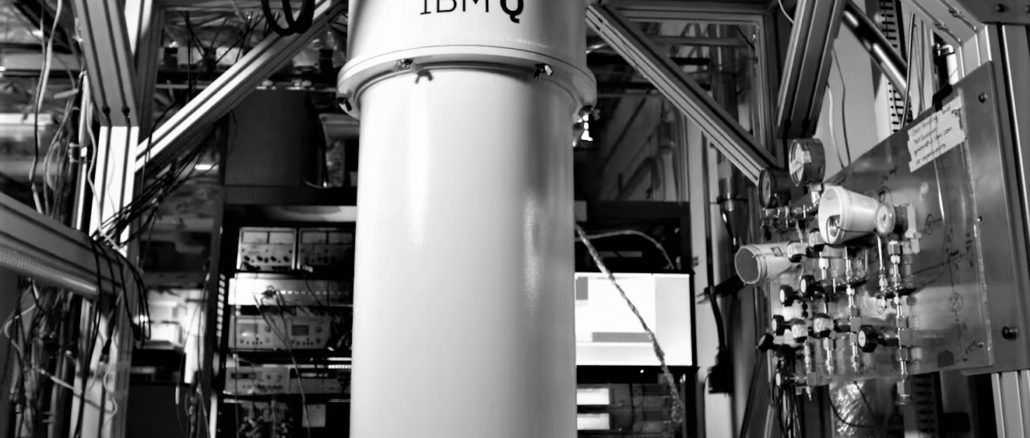
IBM has come up with its newest and most advanced quantum computer to date, which the company claims is “the world’s first integrated universal approximate quantum computing system designed for scientific and commercial use.” The system, known as IBM Q System One, was unveiled at the 2019 Consumer Electronics Show (CES) taking place in Las Vegas, Nevada this week.
The idea behind Q System One is to provide a qubit-powered machine that is more like a conventional computer system, rather than like a research project. To that end, IBM scientist and engineers have incorporated a number of design elements that make the system more powerful and exhibit greater reliability, while also making it easier to maintain and upgrade.
This includes a number of component technologies that work in concert to support a more robust quantum computing experience. In the realm of quantum machines, robustness is mainly a function of how well a system is able to reliably execute quantum programs in an error-free manner, such that qubit decoherence is minimized. For the current crop of quantum machinery, decoherence has turned out to be the critical challenge when it comes to making these systems usable. That’s true not just for IBM machines, but also those being developed by Google, Intel, Rigetti, and others quantum computing wannabes.
According to Bob Sutor, VP of the IBM Q Strategy and Ecosystem at IBM Research, the main goal here was to give the qubits the most ideal environment for computing, that is, where they can freely entangle without decoherence gumming up the works. The approach, says Sutor, was to “build a system where we play every card we can think of to get those qubits the quietist possible space to live in.”
In this case, those “cards” include advance componentry for RF isolation, vibration dampening, and temperature control. In addition, the system includes firmware that monitors and manages system health, as well as hardware than auto-calibrates the qubits for more reliable operation.
Temperature has to be strictly controlled for these superconducting machines to operate properly, since even an increase of a few hundred millikelvins can grind the system to a halt. A cryostat refrigeration unit, as well as a custom-built heat exchanger developed by IBM engineers, serve to keep the temperature of the qubits suitably frigid.
One of the more visible aspects of Q System One is its housing, which is in the form of a nine-by-nine-by-nine-foot air-tight borosilicate glass case supplied by Goppion, a manufacturer of high-tech museum display cases. (Fun fact: Goppion cases enclose the Mona Lisa at the Louvre and the Crown Jewels at the Tower of London.) In this instance, the glass case is being used to isolate IBM’s quantum machinery from external sound, vibrations, and temperature fluctuations, all of which can decohere a system in short order.
The system also sports a motor-driven mechanism that opens the glass enclosure to simplify system maintenance and modular upgrades. With new quantum processors appearing every six to nine months or so, upgrades become critical to keeping the hardware up to date.
To top it off (literally) is a metal cap on the Goppion glass case that serves to block out electromagnetic interference that can lead to various qubit misbehavior. Many superconducting quantum computing systems like the ones IBM build, operate in the 5 GHz range, which just happens to overlap with the kind of WiFi signals that now permeate the airwaves.
The least novel piece of the initial system is the quantum processor itself, which is based on the company’s existing 20-qubit hardware. That’s pretty much top-of-the-line at IBM these days, notwithstanding the 50-qubit prototype currently under development. Customers of the IBM Q Network have had access to 20-qubit systems since 2017.
Q System One had its first trial run at IBM’s Milan center in July 2018 and was subsequently reassembled at the Yorktown facility in September, incorporating the fourth-generation 20-qubit hardware. In December, after initial tuning, the system was turned over to a group of physicists, who, according to Sutor; are so entranced with the machine that they are now loathe to relinquish it for maintenance and testing.
IBM has measured the system’s GHZ (Greenberger–Horne–Zeilinger) state, which represents the degree of entanglement of a cluster of qubits. They have also measured the system’s quantum volume, a benchmark that IBM came up with to determine the amount of quantum computing that can be accomplished on a given platform. At this point though, the company is not providing the results of these metrics to back up its claims for superior performance and reliability. But at least from Sutor’s perspective, Q System One is already in the top tier of quantum computers. “What we have here is a system that is as good as or better than anything else on the planet right now,” Sutor told The Next Platform.
If these new quantum technologies prove themselves, they will most certainly be incorporated into future IBM Q systems. Sutor likens Q System One to IBM’s SAGE system, which was built for the US Air Force back in the 1950s. It was one of the first computers to have a real-time operating system, was able to upgrade on the fly, and offered a simple GUI. The SAGE technologies eventually ended up in the IBM System/360, the company’s workhorse mainframe for much of the 1960s and 1970s. Sutor expect what they learn with Q System One will influence everything they develop in their Q portfolio going forward.
IBM intends to put the next version of Q System One at their Poughkeepsie facility, which will be opening its new Q Quantum Computation Center later this year. That system, along with other Q machines at the center, will join IBM’s Q Network, the company’s commercial cloud-based quantum computing service. Right now, that service is based out of Thomas J. Watson Research Center in Yorktown, New York, which houses IBM’s commercially available quantum computers.
The Q Network has dozens of paying customers, spanning businesses like JP Morgan and Samsung plus research institutions like Oak Ridge National Lab and the University of Oxford. At CES, IBM announced six new high-profile customers, including ExxonMobil, CERN, Argonne National Laboratory, Fermilab, and Lawrence Berkeley National Laboratory. While none of these organization are executing production codes on these systems, they are developing algorithms and techniques that will be used on future, more powerful systems, which are expected to run real-world applications.
The addition of Q System One to the service, along with the new quantum computing center at Poughkeepsie, represents a major step forward for the Q Network and appears to be an indication of the shape of things to come. “This is how you’re going to see IBM quantum computation centers look in the future,” said Sutor.




Be the first to comment